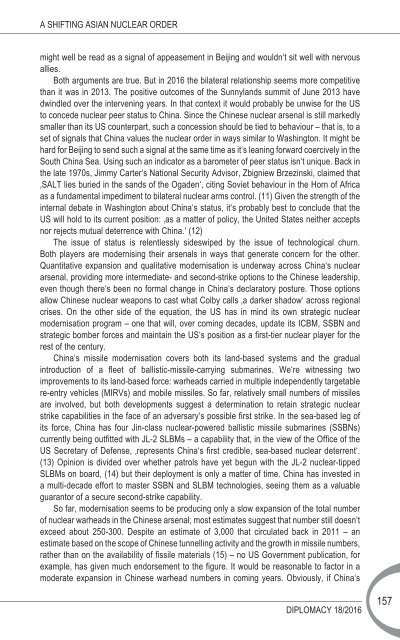DIPLOMACY ДИПЛОМАЦИЯ
2kGfdFv
2kGfdFv
You also want an ePaper? Increase the reach of your titles
YUMPU automatically turns print PDFs into web optimized ePapers that Google loves.
A SHIFTING ASIAN NUCLEAR ORDER<br />
might well be read as a signal of appeasement in Beijing and wouldn’t sit well with nervous<br />
allies.<br />
Both arguments are true. But in 2016 the bilateral relationship seems more competitive<br />
than it was in 2013. The positive outcomes of the Sunnylands summit of June 2013 have<br />
dwindled over the intervening years. In that context it would probably be unwise for the US<br />
to concede nuclear peer status to China. Since the Chinese nuclear arsenal is still markedly<br />
smaller than its US counterpart, such a concession should be tied to behaviour – that is, to a<br />
set of signals that China values the nuclear order in ways similar to Washington. It might be<br />
hard for Beijing to send such a signal at the same time as it’s leaning forward coercively in the<br />
South China Sea. Using such an indicator as a barometer of peer status isn’t unique. Back in<br />
the late 1970s, Jimmy Carter’s National Security Advisor, Zbigniew Brzezinski, claimed that<br />
‘SALT lies buried in the sands of the Ogaden’, citing Soviet behaviour in the Horn of Africa<br />
as a fundamental impediment to bilateral nuclear arms control. (11) Given the strength of the<br />
internal debate in Washington about China’s status, it’s probably best to conclude that the<br />
US will hold to its current position: ‘as a matter of policy, the United States neither accepts<br />
nor rejects mutual deterrence with China.’ (12)<br />
The issue of status is relentlessly sideswiped by the issue of technological churn.<br />
Both players are modernising their arsenals in ways that generate concern for the other.<br />
Quantitative expansion and qualitative modernisation is underway across China’s nuclear<br />
arsenal, providing more intermediate- and second-strike options to the Chinese leadership,<br />
even though there’s been no formal change in China’s declaratory posture. Those options<br />
allow Chinese nuclear weapons to cast what Colby calls ‘a darker shadow’ across regional<br />
crises. On the other side of the equation, the US has in mind its own strategic nuclear<br />
modernisation program – one that will, over coming decades, update its ICBM, SSBN and<br />
strategic bomber forces and maintain the US’s position as a first-tier nuclear player for the<br />
rest of the century.<br />
China’s missile modernisation covers both its land-based systems and the gradual<br />
introduction of a fleet of ballistic-missile-carrying submarines. We’re witnessing two<br />
improvements to its land-based force: warheads carried in multiple independently targetable<br />
re-entry vehicles (MIRVs) and mobile missiles. So far, relatively small numbers of missiles<br />
are involved, but both developments suggest a determination to retain strategic nuclear<br />
strike capabilities in the face of an adversary’s possible first strike. In the sea-based leg of<br />
its force, China has four Jin-class nuclear-powered ballistic missile submarines (SSBNs)<br />
currently being outfitted with JL-2 SLBMs – a capability that, in the view of the Office of the<br />
US Secretary of Defense, ‘represents China’s first credible, sea-based nuclear deterrent’.<br />
(13) Opinion is divided over whether patrols have yet begun with the JL-2 nuclear-tipped<br />
SLBMs on board, (14) but their deployment is only a matter of time. China has invested in<br />
a multi-decade effort to master SSBN and SLBM technologies, seeing them as a valuable<br />
guarantor of a secure second-strike capability.<br />
So far, modernisation seems to be producing only a slow expansion of the total number<br />
of nuclear warheads in the Chinese arsenal; most estimates suggest that number still doesn’t<br />
exceed about 250-300. Despite an estimate of 3,000 that circulated back in 2011 – an<br />
estimate based on the scope of Chinese tunnelling activity and the growth in missile numbers,<br />
rather than on the availability of fissile materials (15) – no US Government publication, for<br />
example, has given much endorsement to the figure. It would be reasonable to factor in a<br />
moderate expansion in Chinese warhead numbers in coming years. Obviously, if China’s<br />
<strong>DIPLOMACY</strong> 18/2016<br />
157


